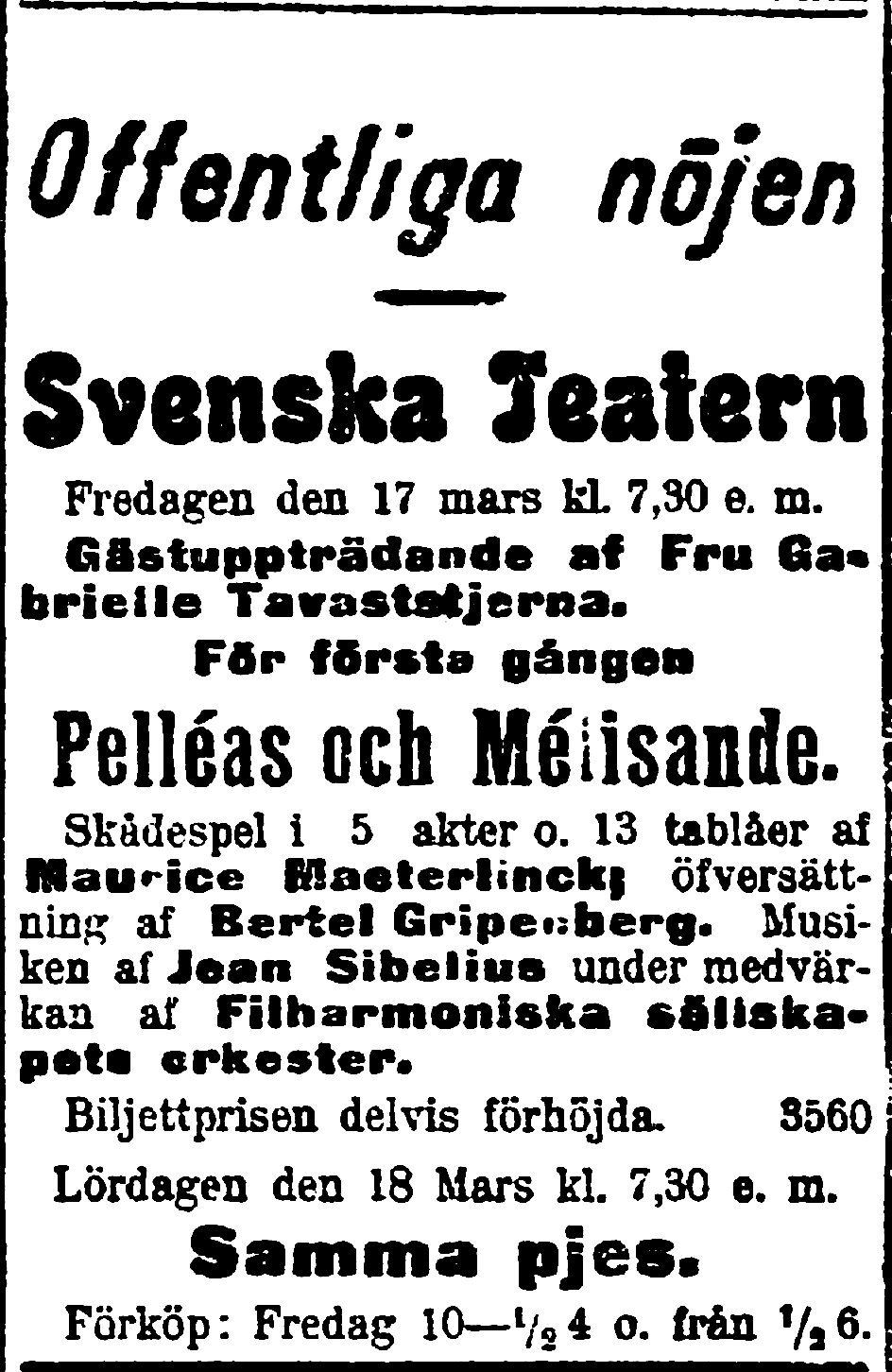Pelléas Et Mélisande (Sibelius) on:
[Wikipedia]
[Google]
[Amazon]
 ''Pelléas et Mélisande'' (''Pelléas och Mélisande''), JS 147 is incidental music by
''Pelléas et Mélisande'' (''Pelléas och Mélisande''), JS 147 is incidental music by
 ''Pelléas et Mélisande'' (''Pelléas och Mélisande''), JS 147 is incidental music by
''Pelléas et Mélisande'' (''Pelléas och Mélisande''), JS 147 is incidental music by Jean Sibelius
Jean Sibelius (; ; born Johan Julius Christian Sibelius; 8 December 186520 September 1957) was a Finnish composer of the late Romantic music, Romantic and 20th-century classical music, early modern periods. He is widely regarded as his countr ...
for Maurice Maeterlinck
Maurice Polydore Marie Bernard Maeterlinck (29 August 1862 – 6 May 1949), also known as Count/Comte Maeterlinck from 1932, was a Belgian playwright, poet, and essayist who was Flemish but wrote in French. He was awarded the 1911 Nobel Prize in ...
's 1892 play '' Pelléas and Mélisande''. Sibelius composed in 1905 ten parts, overtures to the five acts and five other movements. It was first performed at the Swedish Theatre in Helsinki on 17 March 1905 to a translation by Bertel Gripenberg, conducted by the composer.
Sibelius later slightly rearranged the music into a nine movement suite, published as Op. 46, which became one of his most popular concert works.
Movements of the suite
The movements were derived from the followingnumbers
A number is a mathematical object used to count, measure, and label. The most basic examples are the natural numbers 1, 2, 3, 4, and so forth. Numbers can be represented in language with number words. More universally, individual numbers can ...
:
Excluded from the suite is Prelude to Act IV, scene 2, as well as the vocal version of No. 5, Mélisande's Song. Sibelius later made a transcription of the suite for solo piano, excluding the 'At the Seashore' movement.
Orchestration
The work is scored forflute
The flute is a member of a family of musical instruments in the woodwind group. Like all woodwinds, flutes are aerophones, producing sound with a vibrating column of air. Flutes produce sound when the player's air flows across an opening. In th ...
(with piccolo), oboe
The oboe ( ) is a type of double-reed woodwind instrument. Oboes are usually made of wood, but may also be made of synthetic materials, such as plastic, resin, or hybrid composites.
The most common type of oboe, the soprano oboe pitched in C, ...
(with English horn), two clarinet
The clarinet is a Single-reed instrument, single-reed musical instrument in the woodwind family, with a nearly cylindrical bore (wind instruments), bore and a flared bell.
Clarinets comprise a Family (musical instruments), family of instrume ...
s, two bassoons, two horns, timpani
Timpani (; ) or kettledrums (also informally called timps) are musical instruments in the percussion instrument, percussion family. A type of drum categorised as a hemispherical drum, they consist of a Membranophone, membrane called a drumhead, ...
/triangle
A triangle is a polygon with three corners and three sides, one of the basic shapes in geometry. The corners, also called ''vertices'', are zero-dimensional points while the sides connecting them, also called ''edges'', are one-dimension ...
/ bass drum, and strings.
References
Additional reading
*External links
* {{DEFAULTSORT:Pelleas Et Melisande (Sibelius) Suites by Jean Sibelius Incidental music by Jean Sibelius 1905 compositions Adaptations of works by Maurice Maeterlinck Orchestral compositions by Jean Sibelius